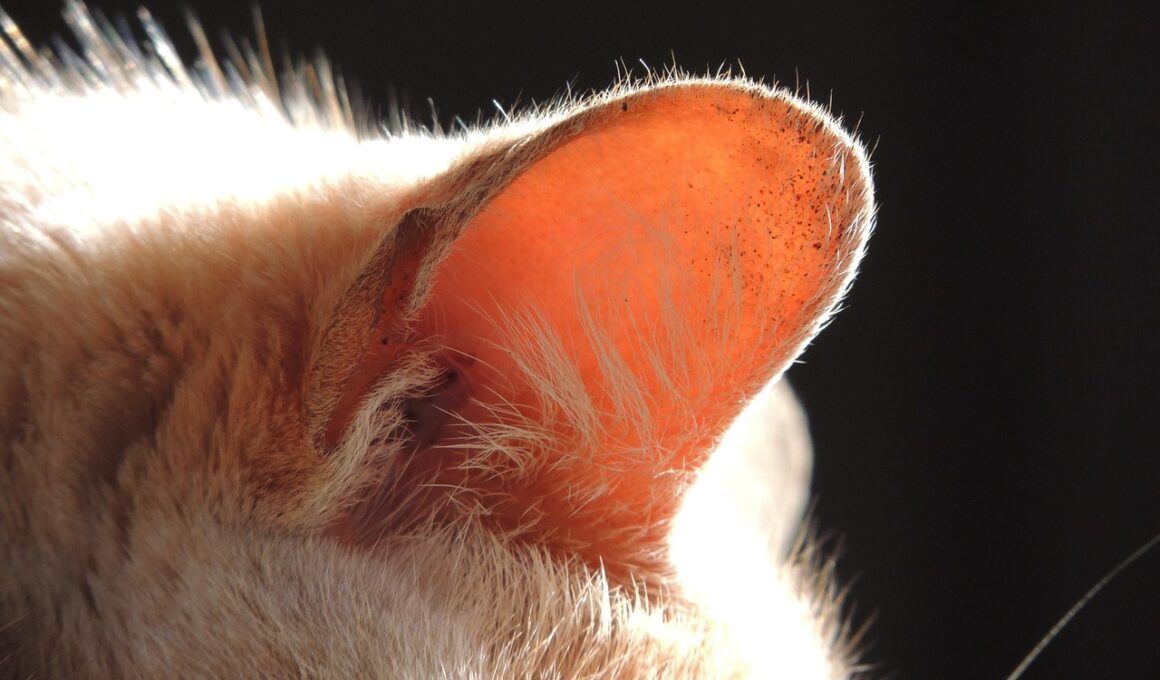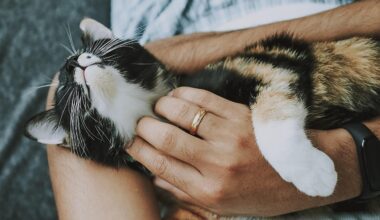The Role of Ear Positions in Cat Communication
Understanding cat body language is essential for cat owners and enthusiasts. One critical aspect is the position of a cat’s ears, which can reveal their emotions and intentions. The ears of a cat are highly expressive tools that communicate various messages. Observing their movements, you can interpret what a cat is feeling. For example, when a cat’s ears are perked up and facing forward, it typically indicates curiosity or excitement. Conversely, flattened ears can signal fear, aggression, or irritation. Learning to read these ear positions helps improve your interaction with your feline friend. Moreover, each cat may have slight variations in how they express themselves through body language. Therefore, it is important to know your cat’s unique traits. Understanding your cat better fosters a smoother relationship between you and your pet. Different environments, situations, and social dynamics also influence ear position and meaning. Each context may provide a more nuanced understanding of your cat’s feelings and thoughts. By paying attention to this specific detail in their communication, owners can enhance their understanding of feline behavior, leading to a happier and healthier environment for both parties involved.
Different ear positions indicate a range of emotions in cats. For example, an alert or interested cat will often have its ears up and forward. This position signifies that the cat is actively engaging with its surroundings and is ready to respond to stimuli. On the other hand, if a cat’s ears are turned sideways or backward, this could indicate uncertainty or annoyance. It is always crucial to consider accompanying body language signs such as tail movement or facial expressions. For instance, a cat with ears back combined with a swishing tail is likely feeling annoyed or threatened. In contrast, a relaxed cat often has ears pointed forward with a still body posture. The ear position can also suggest the cat’s level of comfort depending on the setting. When introducing cats to new environments or pets, observing ear positions becomes even more critical. A cat that feels trapped or stressed may have its ears pinned back. Understanding these subtleties can help prevent incidents and not stress your feline companion. In social situations, both with humans and other cats, their ear positions play a vital role in expressing confidence or fear, marking boundaries, and indicating readiness to interact.
Social Interactions and Play
Ear positions become vital indicators during play and social interactions among cats. During engaging play sessions, cats often display perked-up ears as a sign of excitement and readiness to attack or pounce. This consistent behavior emphasizes their active participation and joy. When two cats socialize or play together, pay attention to their ear movements. If one cat flattens its ears while the other remains upright, the situation may be escalating. Recognizing such signs allows pet owners to intervene before any aggression occurs. Furthermore, cats may also communicate dominance or submission through their ear positions. In tense situations, the cat may lower its head slightly, flattening its ears while adopting a defensive posture. In contrast, a cat that holds its ears up and forward might be asserting its confidence. During these interactions, combining ear position analysis with related behaviors, such as tail movements or vocalizations, offers richer insights into the ongoing dynamics. Additionally, during grooming sessions, ear positions highlight comfort and trust. Ears pointing forward during these moments often signify a relaxed, caring atmosphere for the cat. Thus, analyzing ear positioning enhances interactions between cats, promoting desirable bonding experiences.
Fostering healthy communication between cats often starts with understanding ear signals during their transitional stages. When introducing a new cat to the home, observing the existing cat’s ear positions provides crucial insights into its reactions. Ears held tightly back might indicate stress or suspicion towards a newcomer. Appropriate adjustments in this scenario can create a more welcoming atmosphere. Gradual introductions, using barriers, keeping initial encounters short, and prioritizing each cat’s comfort can help ease tensions effectively. Owners should also be mindful of a cat’s early warning signs during socialization. For instance, abrupt ear movements can signify overstimulation during play or when meeting new cats. Observing these behavioral shifts provides an opportunity to redirect the engagement positively before conflicts arise. When introducing multiple cats, the dynamics can change, requiring further attention to their ear positioning. One cat might display assertiveness while another reacts with submission. All these interactions serve to demonstrate the importance of cat body language. Understanding your cat’s unique way of expressing feelings will cultivate positive relationships in a multi-cat household, ensuring harmony and peace among feline companions throughout various interactions.
The Science Behind Cat Communication
Cats possess a keen ability to communicate non-verbally through ear positions and other body language members. Interestingly, their ear muscles allow for a range of movements and flexibility, contributing significantly to their communication skills. The complex anatomy of the ears allows cats to rotate them 180 degrees independently. This capability helps them pinpoint sounds and attentively respond to their environment, enriching their social interactions. Cats predominantly communicate through visual and auditory signals. For instance, moving their ears can also draw attention to others, indicating curiosity or concern. Furthermore, learning how to read these signals requires observing patterns in specific contexts. A cat’s unique personality further impacts how it expresses itself through ear movements. By engaging in regular observations, cat owners can better understand their pets. Detecting subtle changes in ear positions during various instances enhances overall well-being. Incorporating time for play and exploration establishes a solid rapport with your feline. Understanding the scientific basis of cat communication allows owners to deepen their connection with cats. In the long run, creating a harmonious environment built on mutual understanding improves both your and your cat’s happiness, health, and contentment.
It is essential to note that cultural interpretations of ear positions may differ regarding feline behavior. Various environments may shape behaviors, resulting in distinct communication styles among different breeds. For instance, a Siamese cat is known for its vocalizations, while a Maine Coon might be more reserved. Such differences influence perceptions based on geographic contexts. Conversely, among those familiar with cats, certain ear movements may be recognized similarly across various cultures. Every interaction should be analyzed in context, considering cultural influences and individual cat traits. Furthermore, a cat’s history can also impact its behaviors. Kittens raised in social settings develop distinct ear movements and body language compared to those introduced to unfamiliar environments. Even a cat’s early experiences with humans may determine its responsiveness to ear positioning. Owners should be cautious of these differences when interpreting their cat’s emotions. A strong association between the calming strategies practiced in a household environment will also benefit understanding body language. For optimal outcomes, fostering trust and ensuring consistent, positive interactions will contribute to refined communication patterns among all furry companions.
Conclusion
In conclusion, comprehending ear positions in cat communication plays a crucial role in enhancing relationships with pets. Observing how cats use their ears to express their emotions allows owners to respond adequately, ensuring that the cat feels safe and understood. Regularly monitoring these subtle signals during everyday interactions can lead to identifying underlying emotions, building stronger bonds over time. Gradually, aspects such as maintaining a stress-free atmosphere and encouraging healthy social behavior will benefit both the pet and owner. This attentive approach can encourage more effective communication between cats, reducing anxiety and misunderstandings. Additionally, building an environment that recognizes and reinforces positive behaviors will further strengthen the owner-cat bond. Every interaction offers insight into the intricate dynamics of feline behavior. By analyzing the connection between a cat’s ear positions and emotions, owners create more enriching experiences for their companions. Ultimately, understanding cats at this depth enhances enjoyment, fosters security, and increases the overall quality of life for the cats we cherish. Therefore, investing time in understanding your feline’s body language will not only improve interactions but also promote love and connection in the owner-cat relationship.
In summary, observing ear positions provides valuable insights into cat communication, and owners must prioritize understanding these signs. Ears act as visual indicators of emotion and convey messages about comfort levels, mental state, and intentions. Consequently, becoming attuned to the unique expressions found in each cat will enhance relationships and ensure a harmonious household. Those approaching cat ownership must remain adaptable and patient, recognizing that cats often have unique personalities and responding accordingly. With consistent monitoring and clear communication, cat owners can create a more peaceful coexistence for their furry friends. Offering positive reinforcement when cats display relaxed or engaged body language, including ear positions, fosters trust and encourages similar behavior in the future. Such strategies will result in long-lasting bonds that build on empathy and understanding. Furthermore, promoting an environment enriched with stimulating experiences can minimize undesired behaviors stemming from boredom or anxiety. Every little detail, such as ear movement, plays a role in comprehending overall feline behavior. Thus, being aware of these signals amidst daily life enhances the overall experience of living with and nurturing feline companions. Ensuring that we build and maintain successful communication pathways results in a happier feline family.


